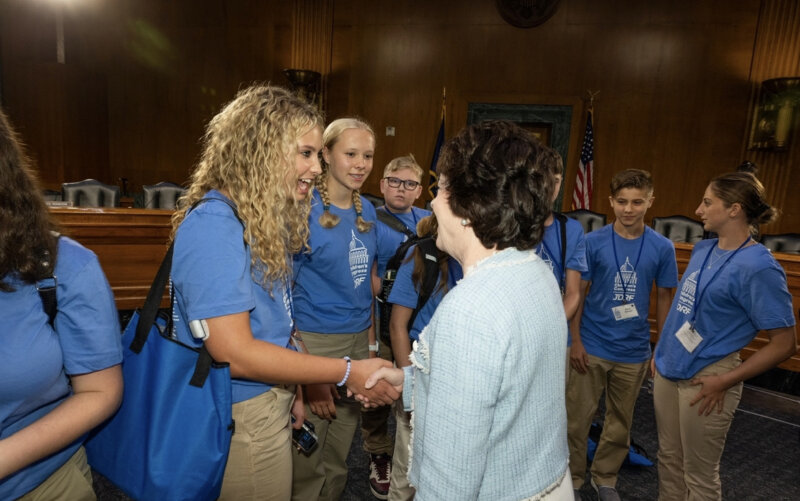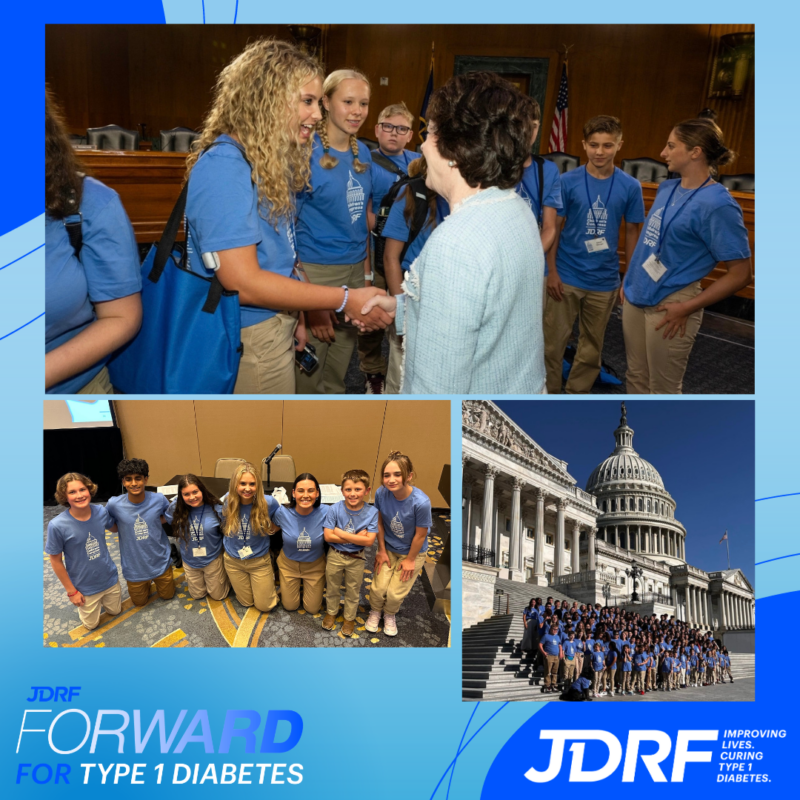Type One in Government
October 25, 2023
by Zara Paul
At the age of seven, my parents received news no parent could ever fathom hearing. After weeks of having flu-like symptoms with no cure, they knew something else was wrong.
Arriving at my local children’s hospital, fatigued and confused, I remember receiving my first-ever finger prick. It was painful, but little did I know this finger prick would soon become a reality of everyday life for me.
My blood sugar test read five hundred fifty milligrams per deciliter.
Dec. 2, 2015, was the day of my diagnosis. This was the day I grew up.
I was diagnosed with type one diabetes; I was labeled a child with a chronic autoimmune disease that I could not escape.
Although I didn’t know what this meant at the time, doctors explained to me that a blood sugar of that range required immediate hospitalization. They then whispered something to my parents. It was inaudible for me, but I remember the change of expression on their face.
They immediately started sobbing.
A few days in the hospital passed, following the same mundane routine; wake up, eat a meal, eat a snack, administer multiple injections, and perform multiple finger pricks.
Juice boxes, feeling lightheaded all the time, having “low” and “high” blood sugars, migraines, stomach aches and frustration were all new factors of everyday life.
I asked doctors, “when will this be over, when can I stop doing these shots?”
I vividly remember their response, “never, well not yet at least, not until someone helps people like you.”
How it all Started
My diagnosis changed my ambitions and priorities. It handed me inevitable responsibility.
Type One Diabetes (T1D) is a non-curable, autoimmune disease. It’s not that uncommon: 244,000 kids around the U.S. are diagnosed with T1D, and the number of diagnosis rates per year only continues to increase.
Type One Diabetes is triggered by genetic factors and autoimmune attacks on the body, the pancreas stops producing insulin, and blood sugar is no longer naturally monitored by the body.
Daily, Type One diabetics must monitor blood sugar levels and continually administer insulin to themselves.
Two months after my diagnosis, I went to a summit called Type One Nation hosted by nonprofit, Juvenile Diabetes Research Foundation. At this summit, I learned about my disease and being involved with JDRF.
I vividly remember seeing a picture of JDRF Youth Ambassadors wearing matching T-shirts, in front of the U.S. Capitol.
I was told that they were going to help pass policies for Type One Diabetics around the nation.
Something clicked in my mind after seeing this image. Creating change became a goal, and attending children’s congress became an aspiration.
From that very moment to the present, I have made it my mission to use my chronic illness as a catalyst for change.
I joined the JDRF Youth Ambassador program soon after the summit and have been a part of it since.
Beginning Advocacy
The JDRF Youth Ambassador program empowers youth living with Type One Diabetes to meet other diabetics, foster community, speak up about their disease, create change, and ultimately have a sense of internal acceptance of the disease.
As an ambassador, I attend and participate in events organized by the group: galas, an annual walk, golf tournaments, and other events aimed at raising awareness and money for Type One Diabetes research.
As I grew more comfortable with my disease, I began to attend more events hosted by JDRF.
I started sharing my experiences with large groups through corporate events, board meetings and even got to speak in many classes for newly diagnosed children at local hospitals and on video calls.
Children’s Congress applications came out, and I learned that I had the opportunity to go to Washington, D.C., to share my experience. The goal is to create legislative change, just like the kids in the photograph I saw at my first JDRF event.
Congressional delegates are chosen every two years, right before the Special Diabetes Program legislation and other diabetes legislation expires. The SDP, as it’s called, provides $150 million for diabetes research and the development of technologies every two years. The aim of the Children’s Congress delegates is to get the legislation renewed.
Delegates fly to Washington for three days of meetings with members of both houses of Congress. They also contribute to a Senate hearing.
Delegates are tasked with persuading members of the government to help renew the diabetes program legislation, the Insulin affordability Act, and maintain federal support for ARPA-H and the FDA. It is through personal narratives, storytelling, and physical presentations Type One diabetics from around the country aim to do this with federal lawmakers.
The federal money that Congress appropriates through the SDP is dispersed throughout different research agencies and technological development initiatives and corporations. Artificial pancreas and insulin pumps, for example, are funded by the SDP.
I, and millions of other diabetics, utilize these technologies daily. They have significantly lowered mortality rates and glycated hemoglobin A1C rates.
This year, the Juvenile Diabetes Research Foundation asked Congress for a $20 million increase in funding for the Special Diabetes Program.
The increase is needed to accelerate work on a major breakthrough in diabetes research – something called islet cell encapsulation. Islet cell encapsulation and transplants are being heavily researched as a hope for a cure. More funding, and a renewal of funding for the Special Diabetes Program, are essential to continue work on this potentially life-changing research.
On top of that, Senator Collins representing Maine and Senator Shaheen representing New Hampshire recently introduced the INSULIN Act of 2023.
The Juvenile Diabetes Research Foundation endorses this bill and has been a key partner in developing it.
This bill includes a $35 commercial insurance copay cap on vials of insulin. It also passes rebates through health plans and encourages biosimilar insulin development and marketing of this entity.
A $35 copay cap is extremely important as insulin prices when uninsured cost around $170-$360 per individual vial. Diabetics need 1-2 vials per month on average, as administering the proper amounts of insulin is the only way to live. Diabetics around the nation are plagued with this extremity while having to balance paying for devices, needles and technology which are also essential to survival.
Children’s Congress Application
Children’s Congress delegates are a key part of the effort to secure funding. During the D.C. trip, the delegates are asked to persuade members of the U.S. Senate and House of Representatives to support this bill, as the cost of insulin has increased six hundred percent in the last twenty years.
I had become aware of the role the delegates played and dreamed of becoming a part of this effort. I submitted my application materials in late October 2022.
In February, I received a large letter in the mail from the Juvenile Diabetes Research Foundation corporate headquarters. I ripped open the letter and excitedly read the large, bolded text: “Congrats you have been chosen as a member of the 2023 Children’s Congressional delegation.”
I was ecstatic. A dream had come true.
In the welcome packet mailed to me, I received a detailed outline of the assignments essential to complete in the next few months as a delegate.
Delegates were required to meet on various Zoom training calls, send out meeting request letters to members of Congress, create videos, social media posts and personal scrapbooks before their trip.
Leading up to the event I got many opportunities to speak about being selected, and what I was excited about.
I was interviewed live by CBS for a morning segment of their show. I also got the privilege of speaking at the North Texas Oklahoma JDRF Gala where I shared my story as to why I was so excited to be attending Children’s Congress.
Although these things were extremely exciting, they were nothing compared to the excitement I felt the night before my journey to Washington.
I was restless; I was ready to leave an impact.
My Time on Capitol Hill
After months of preparation, delegates arrived in Washington on July 9.
We spent the next two days getting to know one another, receiving training, giving practice speeches, and being taught how to navigate Capitol Hill.
And then, the big day arrived.
5 a.m. July 11.
The day started; my emotions were scattered. Parts of me felt thrilled, scared, excited, and even worried.
I quickly reviewed my speaking points, ate a large breakfast, and made my way to Capitol Hill with the other delegates.
Our first task was sitting through a Senate hearing. We got to hear testimonies and the opinions of senators on insulin affordability bills.
Soon after we were dismissed, delegates were assigned certain meeting times with senators and representatives.
I spoke to the two U.S. Senators who represent Texas, John Cornyn and Ted Cruz.
Each senator thoroughly listened to me personifying diabetic experiences, I told them how each legislative decision they made had a broad effect on me and so many more. Delegates spent around 15-30 minutes presenting. There had to be intent, conciseness, and authentic emotion behind every word spoken in these meetings.
I realized soon after departing Capitol Hill, I had never truly told that many people about my diagnosis. I hadn’t widely shared the things I struggled with internally and externally, and my hopes for a future without a disease.
Let alone, I have never shared this aspect of my life, or experienced this level of vulnerability.
As soon as I got home, I was asked to attend a couple different panels and board meetings to share my story and explain how the Children’s Congress delegates spent their time in D.C.
I got to speak to my peers at Type One Nation, the event that first fueled my goal to become a delegate and create change in the first place.
On my return from Washington, I still felt like I needed to continue to create policy and governmental change.
I was honored to join Congressional Youth Advisory Council of U.S. Rep. Beth Van Duyne to help continue to instill my personal beliefs in other types of policy change.
These days, I continue to volunteer for various opportunities to promote the work of the Juvenile Diabetes Research Foundation. I have been offered more public speaking positions with them. I also helped create a Type One diabetic support group intended to create a safe space for congressional delegates around the nation. We use virtual chats and meetings to share our experiences, and foster community.
Ultimately, my goal is to continue to spread awareness about Type One diabetes, create change and help find a cure.
Meanwhile, we’re still waiting for Congress to act on funding the Special Diabetes Program and the Insulin Affordability Act. The threat of a government shutdown because of congressional budget fights has complicated this year’s efforts, but we’re hopeful that everything will be in place before the end of October.
But the larger hope – one that I share with the diabetic community – is a future where we have a cure for this life-complicating chronic condition known as Type One Diabetes.
Original article can be found here: https://evergreen.greenhill.org/type-one-in-government/#



